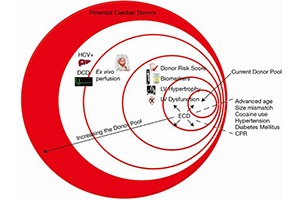Donor selection in the modern era
Abstract
The growing disparity between the supply of donor hearts for transplantation and the demand for such organs has led to liberalization of the criteria for donor heart acceptance over the past few decades. The upper age limit and size restrictions for donor heart acceptance continue to be revised and hearts are being routinely used from donors with left ventricular dysfunction, left ventricular hypertrophy (LVH), cocaine use, multiple medical co-morbidities and after cardiopulmonary resuscitation. This article reviews recent data for use of such “expanded criteria” donor hearts and suggests ways to further increase the donor pool, including use of hearts from donors with hepatitis C and after circulatory determination of death. Donor biomarkers and risk scores may eventually aid in heart acceptance decisions, while ethical issues surrounding information sharing with transplant recipients remain a topic of great debate.
Cover






